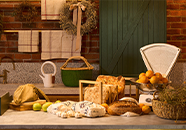
The Blushing Bride, a rare white or pink flower with silky, pointy petals, is somewhat of a legend in the Franschhoek Valley. The story goes that it was discovered in the surrounding mountains in 1773 and came by its romantic name from its use in a rather romantic tradition. A French Huguenot farmer who was in love would wear this flower in his lapel when he decided to propose to the girl he fancied. The pinker the flower, the more serious his intentions were, causing the bride-to-be to blush at the sight of the flower.

Blushing Brides
Sadly, as with other near-extinct fynbos varieties in the region, the Blushing Bride disappeared from sight for many years. It was rediscovered about a century ago and since then conservationists have been determined to return the iconic flower to its former glory.
Today Blushing Brides, rare disas and various kinds of proteas are being brought back to life on the La Motte Wine Estate in Franschhoek, where they can be seen in full bloom in the estate’s large Protea Garden. La Motte’s proud collection of rare flower varieties that are lovingly cultivated and re-established in the area is one of the reasons for it to have been awarded Champion status in the Biodiversity in Wine initiative (BWI).

Protea gardens
Although best known for its international wine brand, La Motte is an estate that has conservation and sustainability at its centre. Nowhere is this more apparent than on the beautiful Organic Walk guiding visitors through the vineyards, fynbos nursery and gardens on the farm and concluding with a tasting of the organically grown Pierneef Sauvignon Blanc.

The Organic Walk
The walk offers visitors the opportunity to see how passionate La Motte is about sustainable farming and conservation. Visitors have the chance to see and smell the Protea Garden and stroll through the sustainably farmed and organically grown vineyards, the indigenous landscaped gardens (this time of year a carpet of lush green and soft purple and white), the nursery where micro greens and orchids are cultivated, and the biodynamic vegetable and herb gardens that supply the Estate’s award-winning restaurant and farm shop with fresh seasonal produce.
Head Chef Chris Erasmus and his colleagues at Pierneef à La Motte restaurant visit the garden in their gumboots every morning to pick out the freshest seasonal produce for their signature Cape Winelands cuisine. Chef Chris also guides on what to plant in the garden and places orders ahead of season. Beautiful things are grown, like purple speckled beans, cucumber-shaped aubergines, peas, watercress, yellow and purple carrots, radicchio, kohlrabi, sour fig, rocket, sweet basil and the fine succulent Pork Bush (“Spekboom”) which can be used in salads.

Early Morning Harvest
La Motte has been farming organically since 2007 and in 2009 received EU and NOP organic certification by SGS in France and NOP organic certification by LACON in Germany. Everything on the farm bears testament to this ethos. La Motte has long been a leader in flora conservation work and sustainable, eco-friendly farming practices in South Africa and this commitment has just earned it the title of South Africa’s top practitioner of sustainable wine tourism by the internationally respected Great Wine Capitals of the World (GWC) network. GWC annually awards top performers in wine tourism in ten wine regions of the world, including South Africa. La Motte was also the overall winner of the South African competition for the second year running, making it the best wine tourism player in the country, thanks to its acclaimed restaurant, art museum, architecture and wine.
A closer look at how things are done on the farm reveals a rare attention to detail in every aspect of the farm’s life. The Rupert family and its wider La Motte family are visibly passionate about sustainable farming and conservation.
More than ten percent of the land is dedicated to conservation. The entire farming operation is set up to be self-sustainable, which means that almost everything that is needed to keep the farm running is produced on the farm. Everything is about quality over quantity – a method that takes time to yield results, but pays dividends in the long run.
One case in point is how water is treated on La Motte as a precious and limited resource. Water used in the wine cellar is treated and purified using natural methods only, never with chemicals. The farm dam provides all the water the farm needs and receives its water from the Kastaiingsrivier and rain. The farm uses drip irrigation to save water and water meters are used throughout the farm to monitor water usage and catch leaks.
Special attention is also paid to the rehabilitation of the soil to keep it healthy and chemical-free. No chemicals have been used on the farm for the last seven years. Special earthworms are fed the kitchen waste to recycle it into concentrated compost that is diluted with water and used across the farm to nourish the soil and plants. Only natural methods are used for pest control and fertilisation. Dry mulch is used to keep out weeds and wet mulch is used to keep in moisture.
Visitors can extend the Organic Walk by taking the 5km hiking trail into the surrounding mountains.

La Motte Hiking Route
Ethereal oil plants such as lavender and buchu, are used for the extraction of essential oils that are used to make the range of Arômes de La Motte body products sold in the farm shop.

Lavender fields
As CEO Hein Koegelenberg explains, La Motte took the path of sustainability at around the turn of the millennium. This meant that quality and consistency would come first. The whole La Motte experience has become testament to this new sustainable way of thinking, and today the estate’s international awards prove that it was a journey the international wine tourism industry supports and honours. It is an ethos that enjoys sharing its passions with guests in a way that both entertains and educates and in the end it has winners on all sides: the estate, its people, its visitors, the environment, the local tourism sector, and the regional economy.
Twitter details:
@lamottewine
#BOWT2013
#Sustainability












